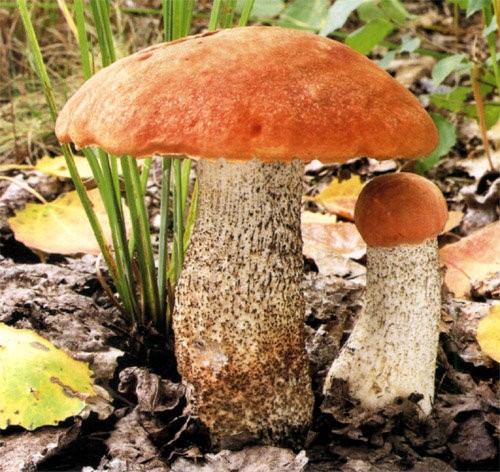Rode boleet (Leccinum aurantiacum)
- Divisie: Basidiomycota (Basidiomycetes)
- Onderverdeling: Agaricomycotina (Agaricomycetes)
- Klasse: Agaricomycetes (Agaricomycetes)
- Subklasse: Agaricomycetidae (Agaricomycetes)
- Bestelling: Boletales (Boletales)
- Familie: Boletaceae (Boletaceae)
- Geslacht: Leccinum (Obabok)
- Type: Leccinum aurantiacum (rode boleet)
- Boletus gewoon
- redhead
- Boletus bloed rood
- Bloedende paddestoel

Rode boletus hoed:
Roodoranje, 5-15 cm in diameter, bolvormig in de jeugd, "uitgerekt" over de stengel, opent met de tijd. De huid is fluweelachtig, steekt merkbaar uit langs de randen. Het vruchtvlees is dicht, wit, op een snede wordt het snel donkerder tot blauwzwart.
Sporenlaag:
Jong wit, daarna grijsbruin, dik, ongelijk.
Sporen poeder:
Geel bruin.
Poot van rode boletus:
Tot 15 cm lang, tot 5 cm in diameter, stevig, cilindrisch, naar beneden toe verdikt, wit, soms groenachtig aan de basis, diep in de grond, bedekt met langsvezelige roodbruine schubben. Voelt aan - fluweelzacht.
Spread:
De rode boletus groeit van juni tot oktober en vormt mycorrhiza, voornamelijk met espen. Waar ze niet worden verzameld, worden ze op kolossale schaal gevonden.
Vergelijkbare soorten:
Regarding the number of varieties of boletus (more precisely, the number of species of mushrooms united under the name “boletus”), there is no final clarity. The red boletus (Leccinum aurantiacum) is characterized by lighter scales on the stalk, a not as wide cap span and a much more solid constitution, like Leccinum versipelle. In texture, it is more like a boletus (Leccinum scabrum). Other species are also mentioned, distinguishing them mainly by the type of trees with which this fungus forms mycorrhiza: Leccinum quercinum with oak, L. peccinum with spruce, Leccinum vulpinum with pine. All these mushrooms are characterized by brown scales on the leg; in addition, the “oak boletus” (sounds something like “meadow mushroom”) is distinguished by its flesh with dark gray spots. However, many popular publications combine all these varieties according to the banner of the red boletus, recording them only as subspecies.
Eetbaarheid:
Tot de hoogste graad.









